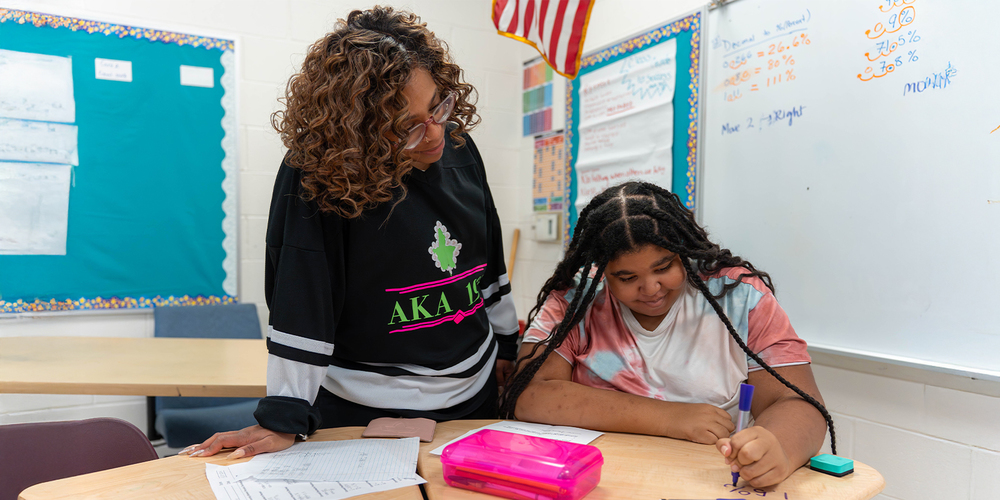When Durham Public Schools announced its school-by-school test data in September 2025, more than half of the district's schools had earned an A, B, or C grade, with the highest number of A schools since the pandemic. The district’s 57* schools earned grades of A,B, or C, with more schools earning an A grade since the 2018-19 school year. (*54 of the district’s 57 schools participate in the accountability program.) Additionally, Durham Public Schools also surpassed its Strategic Plan Goal 1A benchmark for the 2024-25 school year with 47 of 54 schools, or 88.9 percent meeting or exceeding growth, the highest since the 2018-19 school year. This is approximately 17 percent higher than the state’s average.
Join us on a tour of the schools to find out what best practices teachers, staff, and administration used to help their students meet and exceed growth last year.
Students at Lucas Montessori Middle School demonstrated greater academic growth this year than last school year, helping the school move out of low-performing status in North Carolina’s 2024–2025 testing program. Growth measures the progress a student makes over time, taking into account their individual starting point and rate of improvement.
Dr. Sarah Sanchez, the current principal of Lucas, helped open the school in 2012, beginning her tenure there as an assistant principal. She brought with her a strong background in community engagement, classroom instruction, and instructional coaching, along with prior experience as principal of Spring Valley Elementary School. Now in her eighth year as the lead learner at Lucas, Dr. Sanchez credits her dedicated teachers and staff for helping move the school out of low-performing status. Under her leadership, students have also demonstrated significant growth, exceeding their performance from the previous year.
How did Lucas do it?
Dr. Sanchez emphasizes that no single factor guarantees a school’s success. At Lucas, the school’s turnaround began with a shared commitment to academic achievement among all stakeholders. Even before the COVID-19 pandemic, the administration worked with parents and the School Improvement Team to establish a new vision and mission, which have since been revised twice to reflect the school’s evolving goals. These guiding statements are essential because they provide direction, define the school’s values, and keep the focus on student success. Every decision—from analyzing data to planning instruction and differentiating for individual students—aligns with the vision and mission, ensuring that all efforts support meaningful growth for learners.
Additionally, you follow your data, said Sanchez.
“If you know where your students are and understand what they’re struggling with, you can truly help them,” said Dr. Sanchez.
She highlights math teacher Britnee Horne as an exemplar, noting that her students consistently exceed growth expectations each year. Horne, who has taught at Lucas for four years, not only employs>Outside the classroom, Horne coaches cheerleading and co-facilitates the school’s Queens Club, a district initiative that empowers girls of color to make a positive impact in their communities, including their schools. She also maintains regular communication with families, using the school’s MRC-assigned translator to ensure all families can participate and be heard.
Sanchez emphasized that teachers and staff at Lucas maintain high expectations for all students. “You have to look at every student and understand where they are. You can’t push them until you know their starting point. Building relationships is essential and non-negotiable. Getting to know students personally is a must—if you don’t know them, you can’t guide them toward excellence.”
She noted that this philosophy is reflected in the school’s data: the Exceptional Children’s (EC) subgroup showed the most growth at Lucas. “That’s incredibly exciting. We differentiate and engage all students, regardless of how they learn,” said Sanchez.
Brian Martin, a sixth grade math teacher, is an exemplary educator who holds all of his students to high expectations. His classroom is organized into small groups to promote collaboration and discussion, and he has continually refined his teaching strategies to support student growth. Over the years, he has taught multiple grades and subjects to meet the evolving needs of his community. In addition to his classroom responsibilities, Mr. Martin has served as the AIG coordinator at Lucas for several years. He also drives a bus before and after school, including transporting sports teams, and has coached several sports in previous years. Additionally, he has volunteered to lead a MathCounts team. Mr. Martin consistently contributes his time and talents wherever they can benefit students and the school community. He is a dedicated professional who has served countless students in Durham over the past 30 years, and Lucas for 12 years.
Dr. Sanchez has been consistently supported throughout her tenure at Lucas by Curriculum and Instruction Coach Brian Whyte, who has led efforts to advance innovative academic practices. A founding member of the Lucas team, Mr. Whyte has served in multiple roles, including teacher, administrator, and instructional coach. For the past three years, he has also served as the school’s athletic director. He is deeply passionate about supporting both students and teachers—inside and outside the classroom—and remains committed to helping the Lucas community continue to thrive and grow.
Her vision as lead learner at Lucas?
Dr. Sanchez shared that Lucas will “continue on this path of continuous growth.” She expressed her hope that the school will keep improving each year, saying, “I would love for us to move up a letter grade annually. We have the right teachers in place—they have the drive and commitment. It’s not just about academics; it’s about building a community where families want to be. I want families to be lining up to get into Lucas.”

